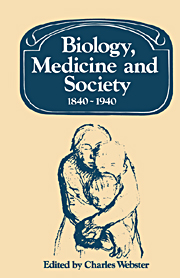Book contents
- Frontmatter
- Contents
- Contributors
- Preface and Acknowledgements
- Introduction
- 1 Women's Health and the Women's Movement in Britain: 1840–1940
- 2 Working-Class Mothers and Infant Mortality in England, 1895–1914
- 3 Theories of the Cell State in Imperial Germany
- 4 Innate Character in Animals and Man: A Perspective on the Origins of Ethology
- 5 Genetics in the United States and Great Britain 1890–1930: A Review with Speculations
- 6 Eugenics and Class
- 7 Sociobiologies in Competition: The Biometrician–Mendelian Debate
- 8 Psychologists and Class
- 9 Measuring Intelligence: English Local Education Authorities and Mental Testing 1919–1939
- Index
2 - Working-Class Mothers and Infant Mortality in England, 1895–1914
Published online by Cambridge University Press: 02 December 2009
- Frontmatter
- Contents
- Contributors
- Preface and Acknowledgements
- Introduction
- 1 Women's Health and the Women's Movement in Britain: 1840–1940
- 2 Working-Class Mothers and Infant Mortality in England, 1895–1914
- 3 Theories of the Cell State in Imperial Germany
- 4 Innate Character in Animals and Man: A Perspective on the Origins of Ethology
- 5 Genetics in the United States and Great Britain 1890–1930: A Review with Speculations
- 6 Eugenics and Class
- 7 Sociobiologies in Competition: The Biometrician–Mendelian Debate
- 8 Psychologists and Class
- 9 Measuring Intelligence: English Local Education Authorities and Mental Testing 1919–1939
- Index
Summary
Writing in 1882, the economist Stanley Jevons had complained that in spite of the steady appearance of articles in learned periodicals on the subject of infant death rates in large towns in Britain, he feared that infant mortality in general remained ‘far too wide and vague an idea to rivet the attention of the public.’ If there was justice in this observation in the 1880s, the situation changed rapidly over the next ten years, and between 1900 and World War I it is reasonable to assert that prevailing rates of infant mortality in England became denned by contemporaries as one of the major social problems of the time.
It is not difficult to understand why this came to be so. Infant mortality had remained high throughout the nineteenth century (averaging about 149 deaths per 1000 live births); but this rate had attracted little attention while general death rates also remained high. However, between the 1860s and 1900 the general death rate (or deaths per 1000 in the total population) had fallen by about 15 per cent. Further, as the Registrar General emphasized in 1907, while the death rate for children aged from one to five years had fallen by 33 per cent over the preceding forty years, that for infants under one year had remained as high for the decade of the 1890s as it had been for the 1860s. Meanwhile, of course, the birth rate had entered upon a period of steady decline; from 35.5 per thousand in 1871–75 to 29.3 per thousand in 1896–1900. In other words, by 1900 fewer babies were being born, a high proportion of whom continued to perish in the first twelve months of life.
- Type
- Chapter
- Information
- Biology, Medicine and Society 1840–1940 , pp. 73 - 98Publisher: Cambridge University PressPrint publication year: 1981
- 1
- Cited by



